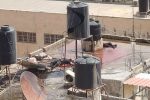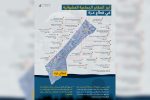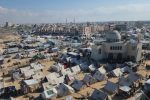“It was about 5:00 am on February 25 1994 the 15th of the holy month of Ramadan. I was an Imam of the worshipers at the Ibrahimi Mosque. I began the second Rak’ah and when I was attempting to get up as I finished kneeling and as I placed my head on the carpet for prayer a terrifying massacre took place. The bullets poured over the heads of the worshipers and their bodies and shouts and screams were heard everywhere.”
These were the words of the Imam of the Ibrahimi Mosque in Hebron (al-Khalil) Sheikh Adel Idris (Abu Anis) describing the morning of the terrible massacre committed by a Jewish settler.
Sheikh Idris said in an exclusive interview with the PIC: “The bodies around me were flying in the air. The brain of one of the martyrs spread over my clothes. Blood was pouring down the carpet. The screams resonated in the place. A horrific massacre by the Jewish settler Baruch Goldstein claimed the lives of 29 Palestinian worshipers and wounded 15 others while one of the worshipers attacked the settler and killed him” he noted.
On Friday 25 February 1994 which was the 15th of Ramadan 1415 AH Jewish settler Baruch Goldstein stood behind a pillar at the Mosque. He waited until the worshipers kneeled down and opened fire using a machine gun while other settlers helped him fill the ammunition that contained explosive bullets. His bullets broke the heads and necks of worshipers.
During the massacre Israeli occupation soldiers at the Mosque closed the doors to prevent worshipers from escaping and prevented those who assembled outside to get in to save the wounded.
During the funeral of the victims of the massacre Israeli soldiers fired at the mourners killing several others and raising the total number of victims to 50 and 150 injuries.
The struggle over the Ibrahimi Mosque
The Ibrahimi Mosque is located in Hebron to the south of the West Bank. It has been the focus of Zionist Jews who turned part of it into a synagogue. The mosque was named after the Prophet Ibrahim peace be upon him who Jews consider to be a Jew. According to Islam he was a Muslim as the holy Quran reads: “Ibrahim was not a Jew and not a Christian but a Muslim.”
Hifzi Abu Snineh the Director of the Ibrahimi Mosque of the Palestinian Waqf authorities said: “The Shamgar Committee which was set up by the occupation authorities to investigate the massacre closed the mosque for six months and prevented prayer there. It concluded that the Mosque should be divided into two sections one for the Jews and another for Muslims.” He noted that during the Jewish holidays the Mosque is closed to Muslims and all Jews and settlers would be allowed in. Jews control 60% of the Mosque while 40% remained under Muslim control.”
Abu Asnina added to the PIC “This was not limited to dividing the Mosque. The Mosque was turned into military barracks and electronic gates have been set up. Muslims can only enter the prayer room. Hundreds of cameras were installed. Israeli occupation forces routinely fire at the young Palestinian men and women who pass through the gates killing many of them.”
One of the most dangerous actions taken by the occupation authorities following the massacre against the city was the closure of Al-Shuhada Street the control of the central vegetable market the Sahla market Khan Shaheen and the market of the caftans which led to the closure of hundreds of Palestinian shops and houses belonging to the Palestinians.
Revenge of resistance
In retaliation for the massacre the Izz el-Deen al-Qassam Brigades the armed wing of the Islamic Resistance Movement (Hamas) carried out five attacks against Israeli targets between April and December 1994 killing 36 Israelis and injuring more than 100 others.
The bloodshed at the Ibrahimi Mosque still fuels the sense of revenge from the Israeli soldiers who killed dozens of Palestinian youths at its gates and yards.
The Israeli occupation forces killed Palestinian child Kallazar Abdel Halim al-Aweiwi at the gate of the Ibrahimi Mosque at the pretext of attempting to stab a soldier. They also killed Anas al-Rajabi Muhammad al-Qawasmi Khuloud al-Tamimi Hussam Abdullah and Su’ad Akhilil in the yards of the Ibrahimi Mosque at the pretext of attempting to kill soldiers and settlers. The bloodshed has never stopped.
The Israeli occupation forces also installed cameras and electronic gates on all entrances and closed most of roads leading to it before Muslims except for one gate with high security measures in addition to the closure of the Hisba market Khan Al-Khalil and Khan Shaheen and the Shuhada and Sahla streets. These actions resulted in the separation of the Old City from its surroundings.
The Israeli occupation reinforced security measures at the entrance of the Mosque and the so-called gate of the cage erecting a checkpoint at Al-Ashraf Gate in a space of 200 square meters and installed 26 cameras inside the Mosque as well as sound sensors lights shutting down all roads leading to the Mosque except for one which is heavily controlled by the Israeli occupation forces.
Implications
Since the massacre took place the attacks on the Ibrahimi Mosque never ceased. Al-Shuhada Street the main lifeblood for the Palestinians has been closed too. This has resulted in the closure of 1800 shops in the Old City and its surroundings.
The massacre was the beginning of a plan of ethnic cleansing separation and isolation and the displacement of Palestinians from the Old City to build the “Jewish city of Hebron”. The life of Palestinians was disrupted as they had to use alleys after the Israeli government decided to close the Old City with its streets and markets and to divide the Mosque between Muslims and Jews.
The Israeli occupation exploited the Hebron Agreement signed with the Palestinian Authority in 1997 to hasten settlement construction in the Old City in which about 40000 Palestinians live known as “H2” which is under the security control of the occupation. Some 35000 settlers living in 27 settlements and dozens of outposts live in area H2 and the surrounding area of Hebron which is home to about 500000 Palestinians.











